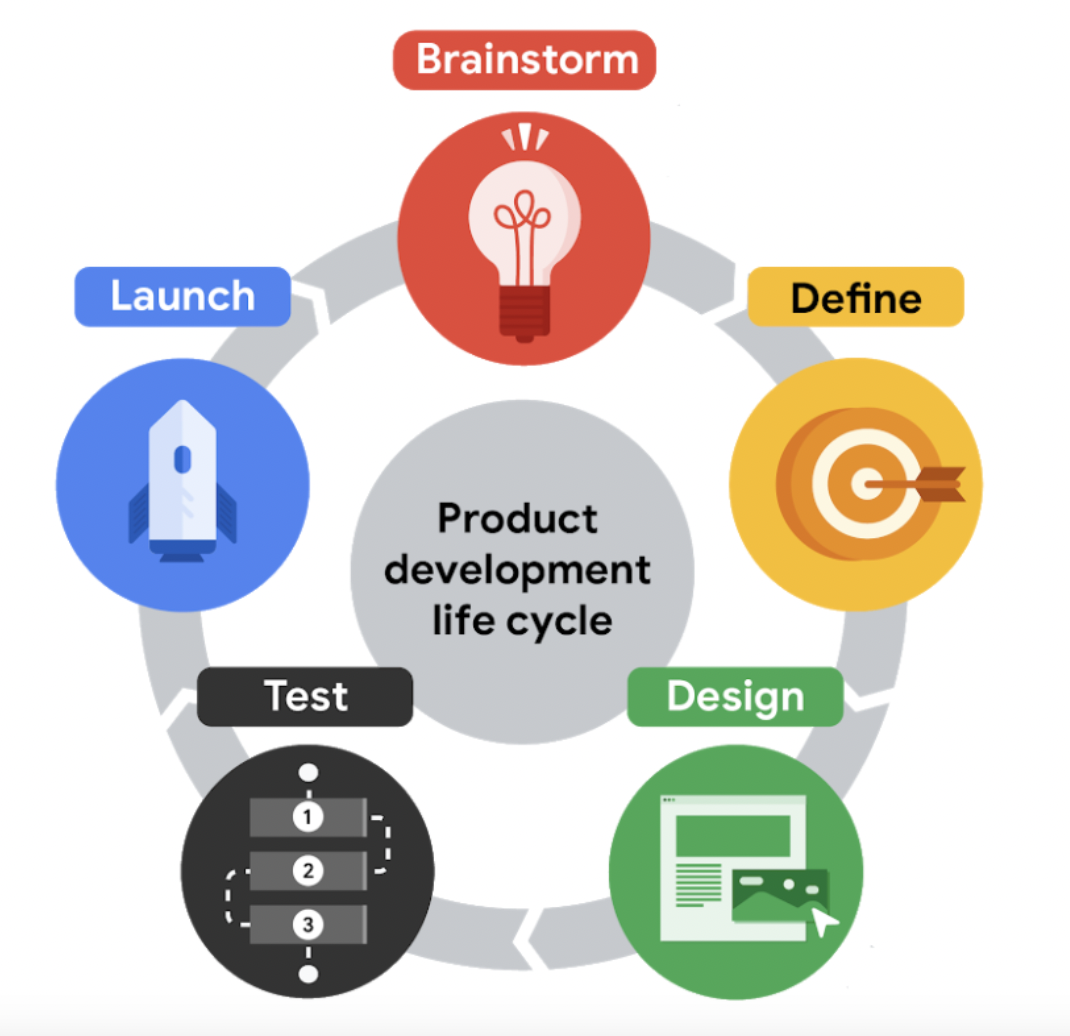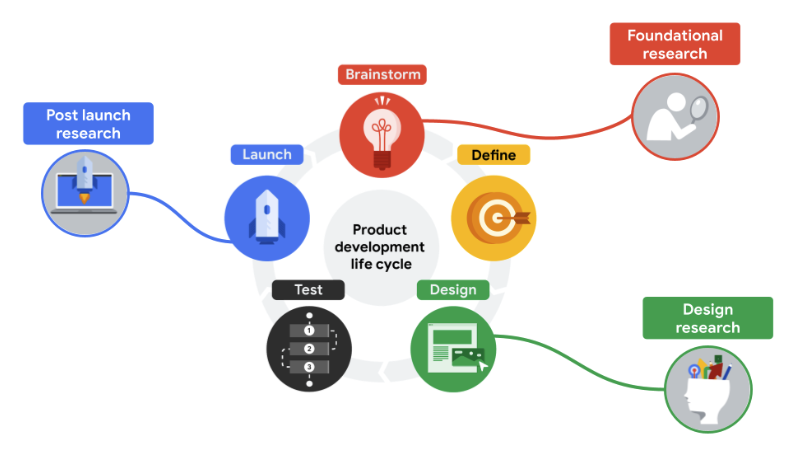A Brief Introduction of UX Design
The basics of user experience design
Definitions
User experience: How a person, the user, feels about interacting with, or experiencing, a product.
Product: A good, service or feature.
Characteristics of a good user experience
Primary characteristics
- usable
- Equitable
- enjoyable
- useful
User experience career
- Interaction designer: Interaction designers focus on designing the experience of a product and how it functions.
- Visual designer: Visual designers focus on how a product or technology looks.
- Motion designer: Motion designers think about what it feels like for a user to move through a product and how to create smooth transitions between pages on an app or website.
- VR/AR designer: Virtual reality (VR) and augmented reality (AR) designers create products that provide users with immersive experiences, unbounded by the limits of the physical world.
- UX researcher: UX researchers conduct studies or interviews that examine how people use a product.
- UX writer: UX writers think about how to make the language within a product clearer so that the user experience is more intuitive.
- UX program manager: UX program managers ensure clear and timely communication, so that the process of building a useful product moves smoothly from start to finish.
- UX engineer: UX engineers translate the design’s intent into a functioning experience, like an app or a website.
- Conversation designer: Conversation designers make it possible for users to have natural conversations to get things done.
Product development life cycle
- brainstorm: An active discovery stage that’s all about generating ideas about the user and potential needs or challenges the user might have.
- define: Using the insights from the brainstorm stage and starting to narrow the focus.
- design: Implementing insights into new designs using various tools.
- test: Evaluating the product design based on the feedback of potential users.
- launch: Sharing a finished version of the product with the public.

product development life cycle
User-centered design
4 steps
- Understand
- Specify
- Design
- Evaluate
User research: Who are my users
- Do my users have impairments or disabilities to consider–whether temporary, situational, or permanent?
- How familiar are my users with technology?
- How are my users accessing the product or service?
- Where and when are my users accessing the product or service?
- Have I considered all my potential users?
Assistive Technology(AT)
Any products, equipment, and systems that enhance learning, working, and daily living for people with disabilities.
- Color modification: high contrast display
- Voice Control: control with voice
- Screen readers: read out loud on screen text
- Alternative text: text to describe images and so on
Design Thinking: A UX design framework
The Design Thinking framework is a user-centered approach to problem-solving that includes activities like research, prototyping, and testing to help you understand who your user is, what their problems are, and what your design should include.

5 phases of design thinking
- Empathize: learn more about the user and their problems, wants, and needs, and the environment or context in which they’ll experience your design
- Define: analyze your research findings from the empathize phase and determine which user problems are the most important ones to solve, and why.
- Ideate: come up with as many design solutions as possible—don’t settle for your first solution because the most obvious solution is not always the right one.
- Prototype: produce an early model of a product that demonstrates its functionality and can be used for testing.
- Test: Interconnected with prototype phase. It is critical to developing the right solution to address your user’s problem, and an organized approach to testing can help you create exceptional user experiences.
Core principles for all frameworks in common
- Focus on the user.
- Create solutions that address the user’s problems.
- Collaborate with teammates across departments.
- Validate your designs.
- Iterate as needed to design the right user experience.
3 kinds of designs
Universal design
The process of creating one product for users with the widest range of abilities and in the widest range of situations.
Problem: one-size-fit-all doesn’t meet all needs
Inclusive design
Making design choices that take into account personal identifiers like ability, race, economic status, language, age, and gender.
Equity-focused design
Thinking through all the aspects of a designed product and making sure the product is both accessible and fair to all genders, races, and abilities. Plus, the designs need to specifically consider underrepresented and excluded groups.
Equality and Equity
- Equality providing the same amount of oppotunity and support
- Equity providing different levels of opportunity and support for each person in order to achieve fair outcomes
Platforms
Platform: The medium that users experience your product on
Brand identity: The visual appearance and voice of a commpany
Design for different platforms
Using responsive web design to solve problems
Things to consider:
- Screen size
- Interaction
- Content layout
- Functionality
Design sprints
A time-bound process, with five phases typically spread over 5 full 8-hour days
goal: solve a problem through designing, prototyping and testing ideas with users.
Benefits
- It’s all about the user
- Value every person in the room
- The best ideas rise to the top
- Time to focus
- Lowers risks
- Versatile scheduling
When to sprint
- Many potential solutions to challenge?
- Cross-functional teams needs to weigh in?
- Challenge scope wide enough?
five phases
- Understand the scope of the design challenge
- Ideate possible solutions
- Decide on the most viable solution
- Create a workable Prototype
- Test the prototype with actual users
Plan design sprints
- User research
- Call in the experts
- Find the right place
- Gather supplies
- Establish sprint rules
- Plan introductions
- Post-sprint planning
Sprint brief
A document that you share with all your attendees to help them prepare for the sprint
What to include
- Sprint challenge: main challenge
- Key deliverables: what you want your team to create during the sprint
- Logistics: when, where, who, sprint leader
- Approvers: need official approvals?
- Resources
- Short-term sprints: assignment development team
- Long-term spents: Plan to secure resources
- Project overview
- Current state of the project
- Roadblocks
- Early wins
- Estimated launch plan
- Sprint schedule: wrap-up
Retrospective
A collaborative critique of the team’s design sprint
Key questions in a retrospective
- What went well?
- What can be improved?
UX Research
Focuses on understanding user behaviors, needs and motivations through observation and feedback.
UX Research is a continuous part of the product development life cycle.
Types
-
Foundamental research
- What should we build?
- What are the user problems?
- how can we solve them?
-
Design research
- How should we build it?
-
Post-launch research
- Did we succeed?

UX Research map
UX researcher qualities
- Empathy: Able to understand someone else’s feelings or thoughts in a situation
- Pragmatism: Focused on reaching goals
- Collaboration: Can work with a range of people, personalities and work styles
UX research Methods
Based on person
- Primary research: Research you conduct yourself
- Secondary research: Research that uses information someone else has put together
Based on data
- Quatitative research(What): Focuses on data that can be gathered by counting or measuring
- Qualitative research (Why): Focuses on observations about why and how things happen
Common Methods
- Interviews: research method used to collect in-depth information on people’s opinions, thoughts, experiences, and feelings.
- Surveys: an activity where many people are asked the same questions in order to understand what most people think about a product.
- Usability studies: a technique that help us evaluate a product by testing it on users.
benefits and drawbacks
Secondary research
Benefits:
- Saves time and money
- Immediately accessible
- Backs up primary research
Drawbacks
- No first-hand user interaction
- No specific user feedback
Interviews
Benefits:
- Understand what users think and why
- Ask follow up questions
Drawbacks:
- Take time and money
- Small sample size
Surveys
Benefits:
- Large sample size
- Fast
- Inexpensive
Drawbacks:
- No in-depth feedback
Usability studies
Benefits:
- First-hand user interaction
- Challenge our assumptions
- In-depth feedback
Drawbacks:
- Only measure how easy a product is to use
- Expensive
- Difference in lab use versus in real life
Bias
Favoring or having prejudice against something based on limited information.
Kinds of biases
Confirmation bias: Occurs when you start looking for evidence to prove a hypothesis you have.
Overcome
- Ask open-ended questions
- Actively listen
- Include a large sample of users
False consensus bias: Overestimate the number of people who will agree with our idea or design, which creates a false consensus.
Overcome
- Identify and articulate your own assumptions
- Survey large groups of people
Primacy bias: Remember the first participant most strongly.
Overcome
- take detailed notes or recordings
- Interview each participant in the same way
Recency bias: It is easiest to remember the last thing you heard.
Overcome
- Same as Primary bias above
Implicit bias (unconscious bias): The collection of attitudes and stereotypes we associate to people without our conscious knowledge.
Overcome
- Reflet on our own behaviors
- Ask others to point out our implicit biases
Sunk cost fallacy: The deeper we get into a project we’ve invested in, the harder it is to change course without feeling like we’ve failed or wasted time.
Overcome
- Break down your project into smaller phases
- Outline points where you can decide whether to continue or stop
Reference
Foundations of User Experience (UX) Design course provided by Google on Coursera